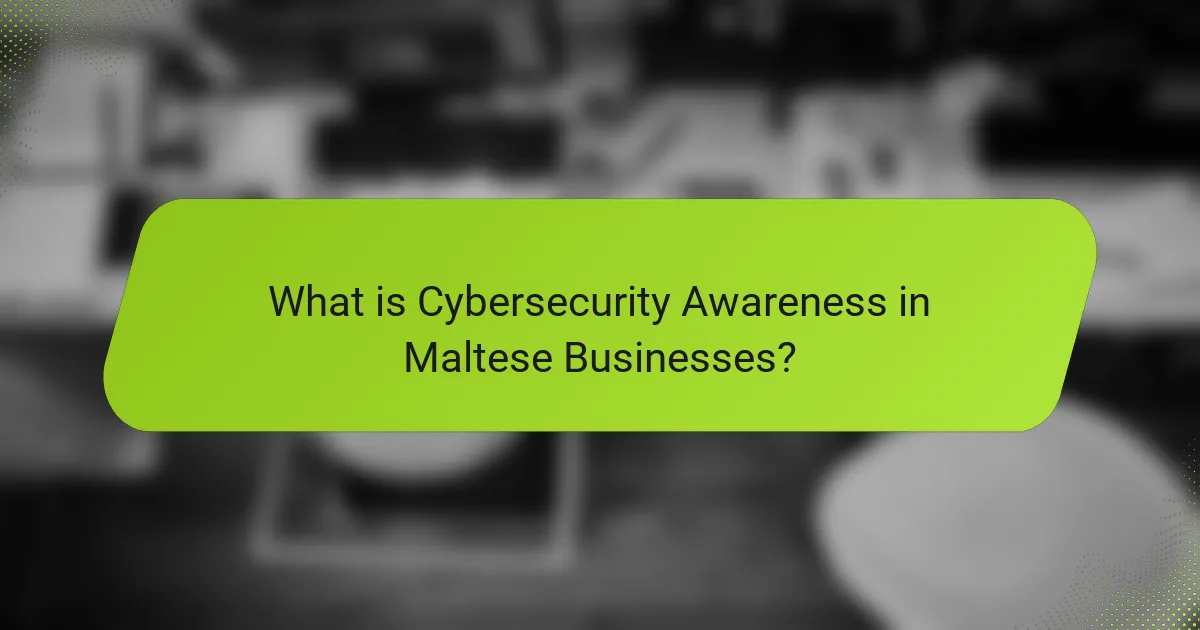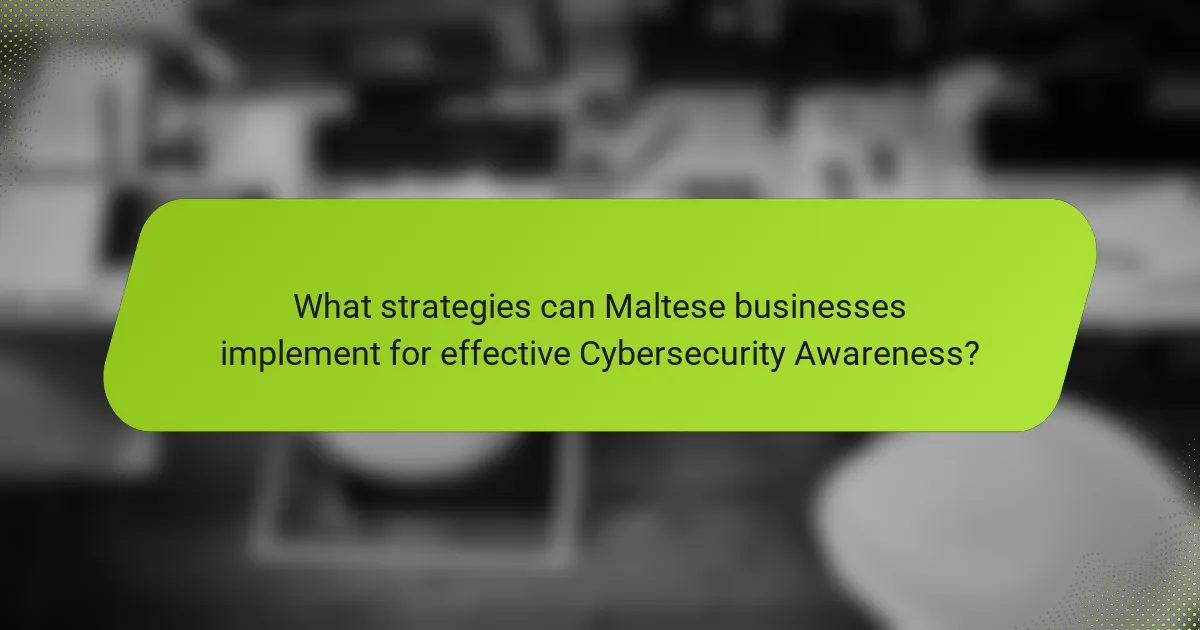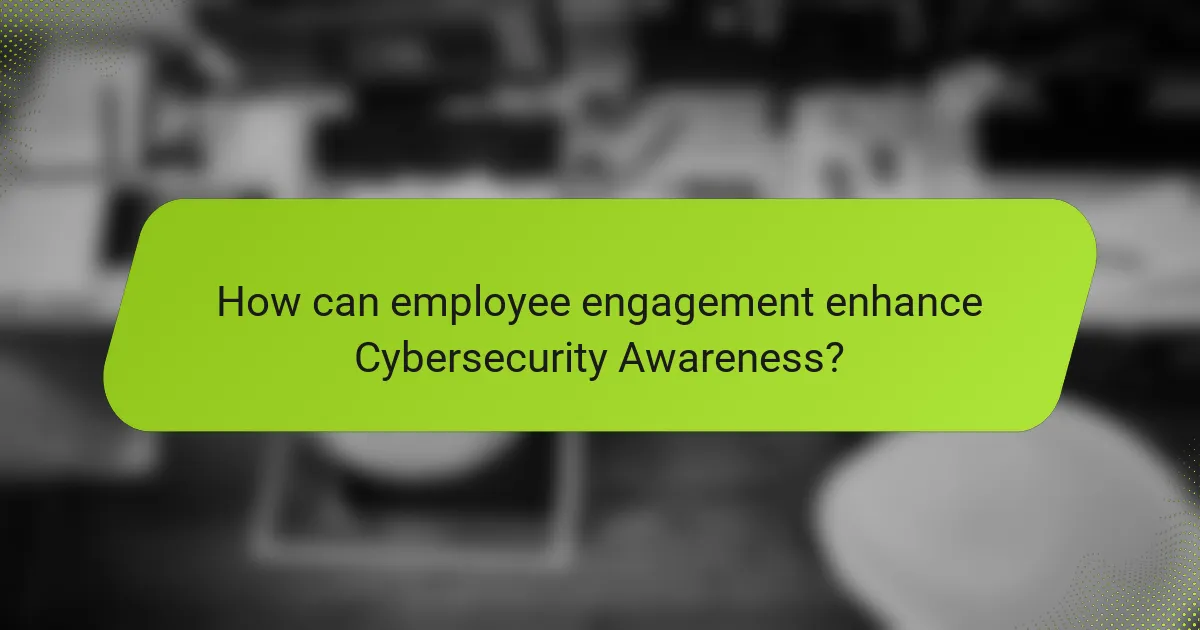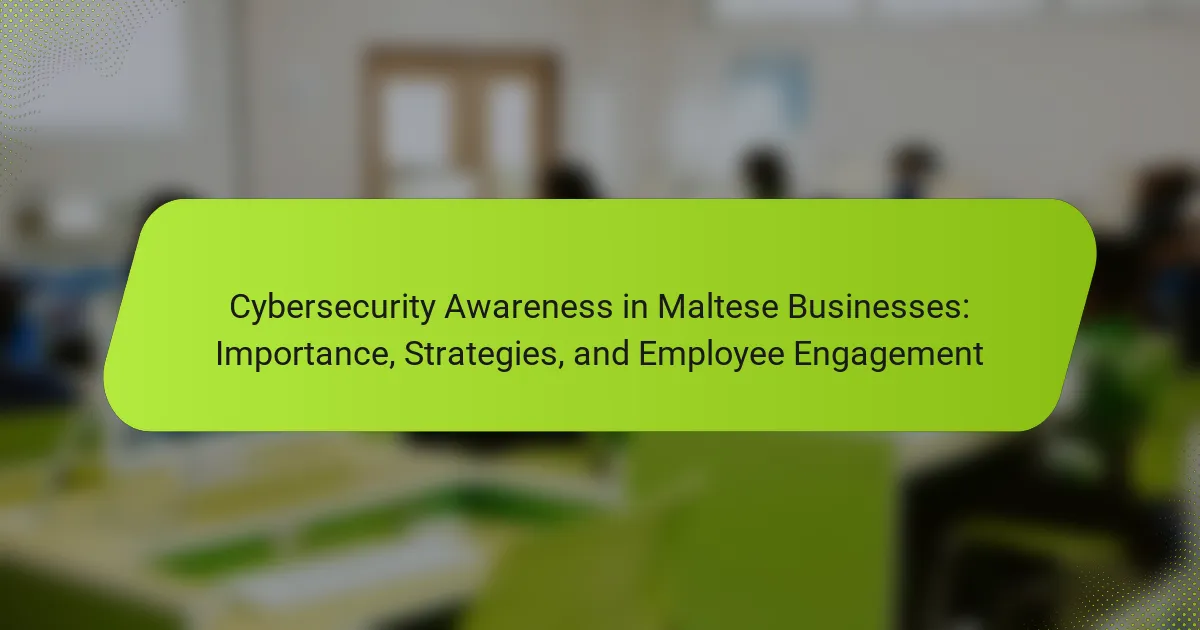
What is Cybersecurity Awareness in Maltese Businesses?
Cybersecurity awareness in Maltese businesses refers to the understanding and knowledge of cybersecurity risks and best practices among employees. This awareness is crucial for protecting sensitive information and maintaining operational integrity. Maltese businesses face increasing cyber threats, making awareness training essential. Research indicates that organizations with strong cybersecurity awareness programs reduce the risk of breaches significantly. In 2022, 70% of Maltese companies reported cybersecurity incidents, highlighting the need for improved awareness. Regular training sessions and updates on emerging threats enhance employee vigilance. Overall, fostering cybersecurity awareness is vital for safeguarding Maltese businesses against cyberattacks.
Why is Cybersecurity Awareness crucial for businesses in Malta?
Cybersecurity awareness is crucial for businesses in Malta to protect sensitive data and maintain operational integrity. With the increasing prevalence of cyber threats, organizations face heightened risks of data breaches and financial losses. According to the Malta Communications Authority, cyber incidents have risen significantly in recent years, emphasizing the need for robust security practices. Employees are often the first line of defense; thus, training them in cybersecurity can significantly reduce risks. A study by the European Union Agency for Cybersecurity indicates that informed employees can prevent up to 85% of cyber incidents. Therefore, fostering a culture of cybersecurity awareness is essential for safeguarding businesses in Malta.
What are the potential risks of ignoring cybersecurity awareness?
Ignoring cybersecurity awareness can lead to significant risks for businesses. One major risk is increased vulnerability to cyberattacks. Without proper awareness, employees may fall victim to phishing scams, leading to data breaches. According to the 2021 Cybersecurity Workforce Study by (ISC)², 70% of organizations experienced a cyber incident due to human error. This highlights the critical role of awareness in preventing such incidents. Additionally, ignoring cybersecurity awareness can result in financial losses. The average cost of a data breach is approximately $4.24 million, as reported by IBM. Furthermore, reputational damage can occur, affecting customer trust and loyalty. In summary, neglecting cybersecurity awareness exposes businesses to attacks, financial losses, and damage to their reputation.
How does cybersecurity awareness impact business reputation?
Cybersecurity awareness significantly impacts business reputation. A well-informed workforce can prevent data breaches and cyber incidents. This proactive stance builds customer trust and confidence. In contrast, poor cybersecurity awareness can lead to security failures. Such failures often result in negative publicity and loss of customer trust. According to a 2020 study by IBM, companies with strong security awareness programs experience 70% fewer security incidents. This statistic underscores the correlation between awareness and reputation. Thus, investing in cybersecurity training enhances both security posture and public perception.
What are the key components of Cybersecurity Awareness?
The key components of Cybersecurity Awareness include understanding threats, recognizing vulnerabilities, and implementing best practices. Employees must be aware of phishing attacks, malware, and social engineering tactics. Training programs should cover password management, data protection, and safe browsing habits. Regular updates on emerging threats enhance awareness. Organizations should foster a culture of security by encouraging reporting of suspicious activities. Effective communication about policies and procedures is essential. Continuous education ensures that employees remain vigilant and informed. These components collectively reduce the risk of cyber incidents in businesses.
What training methods are effective for enhancing cybersecurity awareness?
Interactive training sessions are effective for enhancing cybersecurity awareness. These sessions engage employees through hands-on activities and real-world scenarios. Gamified learning modules also increase retention by making training enjoyable. Regular phishing simulations help employees recognize and respond to threats. E-learning platforms provide flexibility and allow for self-paced learning. Workshops led by cybersecurity experts offer insights into current threats and best practices. Continuous reinforcement through newsletters and updates keeps cybersecurity top of mind. Research indicates that organizations using these methods see a significant reduction in security incidents.
How do policies and procedures contribute to cybersecurity awareness?
Policies and procedures enhance cybersecurity awareness by providing clear guidelines for employees. They define acceptable behaviors regarding data protection and internet usage. This clarity helps employees understand their responsibilities in maintaining security. Regular training sessions based on these policies reinforce the importance of cybersecurity. Research indicates that organizations with well-defined cybersecurity policies experience fewer security breaches. A study by the Ponemon Institute found that companies with comprehensive security policies reduced incidents by 45%. Thus, effective policies and procedures are crucial in fostering a culture of cybersecurity awareness.

What strategies can Maltese businesses implement for effective Cybersecurity Awareness?
Maltese businesses can implement several strategies for effective Cybersecurity Awareness. First, they should conduct regular training sessions for employees. These sessions can cover topics such as phishing, password management, and safe internet practices. Second, businesses should establish clear cybersecurity policies. These policies should outline acceptable use of technology and data protection measures. Third, they can utilize simulated phishing attacks to test employee awareness. This method helps identify vulnerabilities and reinforces training. Fourth, organizations should promote a culture of security. Encouraging open communication about cybersecurity issues fosters vigilance among employees. Lastly, businesses should stay updated on cybersecurity trends and threats. Regular updates ensure that employees are aware of new risks and best practices.
How can businesses assess their current cybersecurity awareness levels?
Businesses can assess their current cybersecurity awareness levels through surveys and training assessments. Surveys can gauge employees’ understanding of cybersecurity policies and best practices. Training assessments can evaluate the effectiveness of existing cybersecurity training programs. Regular phishing simulations can identify vulnerabilities in employee responses to potential threats. Tracking incident reports can provide insights into awareness gaps. Conducting focus groups can reveal qualitative data on employee perceptions of cybersecurity. Benchmarking against industry standards can help businesses understand their position in cybersecurity awareness. These methods collectively provide a comprehensive view of cybersecurity awareness within the organization.
What tools can be used for cybersecurity assessments?
Common tools for cybersecurity assessments include Nessus, Qualys, and OpenVAS. Nessus is widely used for vulnerability scanning. It identifies vulnerabilities in systems and applications. Qualys offers a cloud-based solution for continuous security monitoring. OpenVAS is an open-source tool that provides comprehensive vulnerability scanning. Other tools include Burp Suite for web application security testing and Metasploit for [censured] testing. These tools help organizations identify and mitigate security risks effectively.
How can employee feedback improve cybersecurity strategies?
Employee feedback can significantly enhance cybersecurity strategies by identifying vulnerabilities and improving awareness. Employees often encounter security issues firsthand. Their insights can reveal gaps in current protocols. This feedback helps organizations tailor training programs effectively. For instance, a study by IBM found that organizations with strong employee engagement in cybersecurity reduced security incidents by 70%. Regular feedback loops create a culture of security. This encourages proactive behavior among staff, leading to a more secure environment. Engaged employees are more likely to report suspicious activities. Thus, incorporating employee feedback is vital for robust cybersecurity strategies.
What role does technology play in cybersecurity awareness strategies?
Technology is crucial in cybersecurity awareness strategies. It facilitates the delivery of training and resources to employees. Various tools, such as online training platforms and simulations, enhance learning experiences. Real-time threat detection systems inform employees about current risks. Additionally, technology enables the assessment of employee knowledge through quizzes and feedback mechanisms. Reports indicate that organizations using technology for awareness training see a 70% improvement in employee compliance. This showcases the effectiveness of integrating technology into cybersecurity awareness efforts.
What types of cybersecurity tools should businesses consider?
Businesses should consider several types of cybersecurity tools to protect their digital assets. Essential tools include firewalls, which monitor and control incoming and outgoing network traffic. Antivirus software is crucial for detecting and removing malware from systems. Intrusion detection systems (IDS) help identify unauthorized access attempts. Data encryption tools safeguard sensitive information by converting it into unreadable formats. Additionally, security information and event management (SIEM) systems provide real-time analysis of security alerts. Regular updates and patches for software are necessary to fix vulnerabilities. Multi-factor authentication (MFA) adds an extra layer of security for user access. These tools collectively enhance a business’s cybersecurity posture, reducing the risk of data breaches and cyberattacks.
How can businesses leverage technology for ongoing training?
Businesses can leverage technology for ongoing training by implementing e-learning platforms and virtual training sessions. E-learning platforms offer flexible access to training materials anytime and anywhere. This flexibility allows employees to learn at their own pace. Virtual training sessions can facilitate real-time interaction with trainers and peers. These sessions can incorporate simulations and role-playing to enhance engagement. Additionally, businesses can use Learning Management Systems (LMS) to track employee progress and performance. According to a report by the Association for Talent Development, companies that utilize technology for training see a 42% increase in employee engagement. This demonstrates the effectiveness of technology in enhancing training initiatives.

How can employee engagement enhance Cybersecurity Awareness?
Employee engagement can enhance cybersecurity awareness by fostering a culture of responsibility and vigilance. Engaged employees are more likely to participate in training programs. They also tend to share best practices and insights with colleagues. This creates a collaborative environment focused on security.
Research shows that companies with high employee engagement have fewer security incidents. For example, a study by the Ponemon Institute found that engaged employees are 50% less likely to click on phishing links. Increased communication about cybersecurity issues also helps reinforce awareness. Regular discussions keep security top of mind for employees.
Ultimately, engaged employees contribute to a proactive approach to cybersecurity. This leads to a more secure organizational environment.
What are effective methods for engaging employees in cybersecurity training?
Interactive training sessions are effective methods for engaging employees in cybersecurity training. These sessions encourage participation and foster a collaborative learning environment. Gamification elements, such as quizzes and competitions, can enhance engagement and retention. Real-life scenarios help employees relate to the material and understand its relevance. Regular updates on current threats maintain interest and highlight the importance of ongoing education. Incorporating feedback mechanisms allows employees to voice their concerns and suggestions. A blend of online and in-person training caters to diverse learning preferences. Research shows that interactive and practical methods significantly improve knowledge retention and application in the workplace.
How can gamification improve employee participation in cybersecurity awareness programs?
Gamification can significantly improve employee participation in cybersecurity awareness programs. It engages employees through interactive and game-like elements. This approach makes learning more enjoyable and less intimidating. Employees are more likely to participate when they feel motivated by rewards or competition. Studies show that gamified training can increase retention rates by up to 60%. For example, a report by the Association for Talent Development found that gamification can lead to a 50% increase in engagement levels. By incorporating leaderboards, quizzes, and badges, organizations can create a sense of achievement. This encourages employees to complete training modules and apply their knowledge. Overall, gamification transforms cybersecurity training into an engaging experience that boosts participation.
What incentives can be offered to encourage employee involvement?
Incentives to encourage employee involvement include financial rewards, recognition programs, and professional development opportunities. Financial rewards can motivate employees to participate in cybersecurity initiatives. These may include bonuses or gift cards for completing training. Recognition programs, such as employee of the month, can boost morale and engagement. Employees who feel appreciated are more likely to contribute actively. Professional development opportunities, such as workshops or certifications, can enhance skills and knowledge. This, in turn, fosters a culture of involvement. Studies show that engaged employees are 17% more productive, highlighting the impact of effective incentives.
How can businesses measure the effectiveness of their cybersecurity awareness initiatives?
Businesses can measure the effectiveness of their cybersecurity awareness initiatives through various methods. One effective approach is to conduct pre- and post-training assessments. These assessments evaluate employee knowledge before and after the training sessions. By comparing scores, businesses can quantify improvements in understanding.
Another method is to analyze the number of reported security incidents. A decrease in incidents after training indicates increased awareness. Additionally, businesses can track employee engagement with training materials. High engagement levels often correlate with better retention of information.
Surveys can also provide insights into employee perceptions of cybersecurity practices. Feedback from employees helps identify areas needing improvement. Regular phishing simulations can test employees’ responses to potential threats. The results can highlight the effectiveness of training.
Finally, businesses can benchmark their performance against industry standards. This comparison provides context for their results. Collectively, these methods create a comprehensive view of the initiatives’ effectiveness.
What metrics should be tracked to assess employee engagement?
Key metrics to track for assessing employee engagement include employee satisfaction scores, turnover rates, and participation in training programs. Employee satisfaction scores provide insights into how employees feel about their roles and the organization. High turnover rates can indicate low engagement or dissatisfaction among employees. Participation in training programs reflects employees’ willingness to develop skills, which correlates with engagement levels. Additionally, feedback from employee surveys can highlight areas for improvement. Regularly monitoring these metrics enables organizations to gauge employee engagement effectively.
How can feedback loops enhance the impact of cybersecurity training?
Feedback loops can enhance the impact of cybersecurity training by providing continuous improvement and reinforcement of knowledge. They allow trainers to assess employee understanding and retention of information. Regular feedback helps identify knowledge gaps and areas needing further clarification. This process encourages active participation and engagement from employees. According to a study by the National Cyber Security Centre, organizations that implement feedback mechanisms report a 30% increase in employee awareness and responsiveness to cyber threats. Feedback loops also foster a culture of accountability, motivating employees to take cybersecurity seriously. Overall, integrating feedback into training programs leads to more effective learning outcomes and a stronger security posture.
What best practices should Maltese businesses follow for Cybersecurity Awareness?
Maltese businesses should implement regular cybersecurity training for employees. This training should cover phishing awareness, password security, and safe internet practices. Regular updates on emerging threats are essential. Businesses must also establish clear policies for data protection and incident response. Conducting simulated phishing attacks can help assess employee readiness. Utilizing strong, unique passwords and multi-factor authentication enhances security. Regular software updates and security patches are crucial to protect systems. Finally, fostering a culture of cybersecurity awareness encourages proactive behavior among employees. These practices collectively mitigate risks and enhance the organization’s security posture.
Cybersecurity awareness in Maltese businesses encompasses the understanding of cybersecurity risks and best practices among employees, which is essential for protecting sensitive information and ensuring operational integrity. With a significant rise in cyber incidents reported in Malta, fostering a culture of cybersecurity awareness through regular training and clear policies is crucial to mitigate risks. The article outlines the importance of employee engagement, effective training methods, and the impact of technology on enhancing cybersecurity awareness. Additionally, it discusses strategies for assessing current awareness levels and measuring the effectiveness of initiatives, emphasizing the role of feedback loops and best practices in creating a secure business environment.
